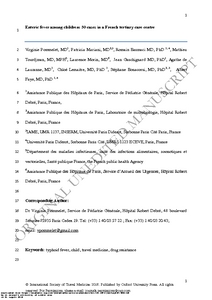Pommelet, V; Mariani, P; Basmaci, R; Tourdjman, M; Morin, L; Gaschignard, J; Lauzanne, AD; Lemaitre, C; Bonacorsi, S; Faye, A
(2018)
Enteric fever among children: 50 cases in a French tertiary care centre.
J Travel Med, 25 (1).
tay059.
ISSN 1708-8305
https://doi.org/10.1093/jtm/tay059
SGUL Authors: Basmaci, Romain
![[img]](http://sgultest.da.ulcc.ac.uk/110030/1.hassmallThumbnailVersion/tay059.pdf)  Preview |
|
PDF
Accepted Version
Available under License ["licenses_description_publisher" not defined].
Download (804kB)
| Preview
|
Abstract
Background: Enteric fever in France is primarily travel-associated. Characteristics of paediatric cases are scarce and information from field studies in endemic countries might not be generalizable to non-endemic countries. Methods: In this retrospective study, we reviewed all cases of typhoid and paratyphoid fever treated in a French paediatric tertiary care centre from 1993 through 2015. Results: Fifty cases of enteric fever due to Salmonella enterica serovar Typhi (n = 44) and Paratyphi (n = 6) were identified. Sixty-one percent of the children had travelled to Africa and 34 % to the Indian subcontinent. Among travel-associated cases, eighty-five percent were visiting friends and relatives (VFR). Ninety-six percent had high fever associated with gastrointestinal symptoms. Anaemia (66%), elevated CRP (80%), transaminitis (87%) and mild hyponatremia (50%) were the main biological findings. Blood cultures were positive in 90% of cases. Twelve strains (24%) were resistant at least to one antibiotic, and all of them had been isolated since 2003, increasing the resistance rate during this last period to 43% (12/28). Ceftriaxone was administered to 71 patients for a median duration of 6 days (IQR: 4‒8). The median time to apyrexia after onset of treatment was 4 days (IQR: 2‒5 days). Complications occurred in 9 children with 5 (10%) presenting neurologic disorders. All 50 patients recovered. Conclusion: In France, paediatric enteric fever is mainly a travel-associated disease and occurs in patients returning from a prolonged stay in an endemic area. Children VFR are at high risk and should be a priority target group for pre-travel preventive measures. The increase in antibiotic resistance reflects the situation in endemic countries and is a major concern.
| Item Type: |
Article
|
| Additional Information: |
This is a pre-copyedited, author-produced version of an article accepted for publication in Journal of Travel Medicine following peer review. The version of record Virginie Pommelet, Patricia Mariani, Romain Basmaci, Mathieu Tourdjman, Laurence Morin, Jean Gaschignard, Agathe de Lauzanne, Chloé Lemaitre, Stéphane Bonacorsi, Albert Faye; Enteric fever among children: 50 cases in a French tertiary care centre, Journal of Travel Medicine, Volume 25, Issue 1, 1 January 2018, tay059 is available online at: https://doi.org/10.1093/jtm/tay059 |
| Keywords: |
Tropical Medicine, 1103 Clinical Sciences, 1117 Public Health And Health Services, 1506 Tourism |
| SGUL Research Institute / Research Centre: |
Academic Structure > Infection and Immunity Research Institute (INII) |
| Journal or Publication Title: |
J Travel Med |
| ISSN: |
1708-8305 |
| Language: |
eng |
| Dates: |
| Date | Event |
|---|
| 15 September 2018 | Published | | 30 July 2018 | Published Online | | 27 July 2018 | Accepted |
|
| Publisher License: |
Publisher's own licence |
| PubMed ID: |
30060197 |
 |
Go to PubMed abstract |
| URI: |
http://sgultest.da.ulcc.ac.uk/id/eprint/110030 |
| Publisher's version: |
https://doi.org/10.1093/jtm/tay059 |
Statistics
Item downloaded times since 01 Aug 2018.
Actions (login required)
 |
Edit Item |



